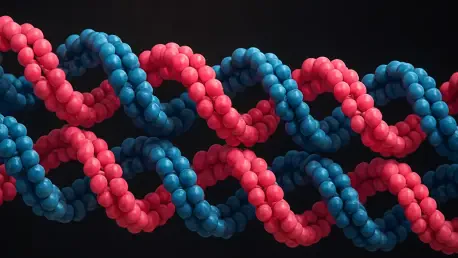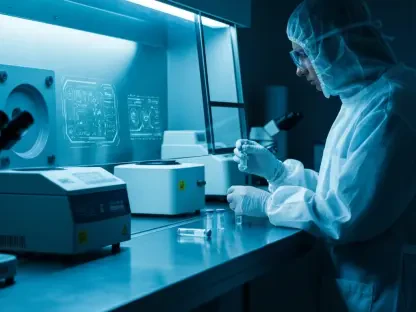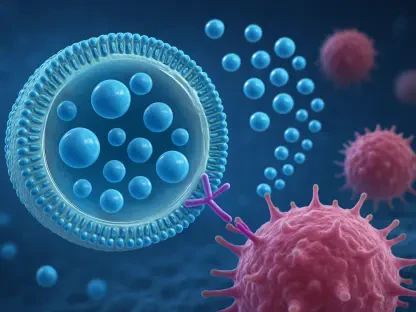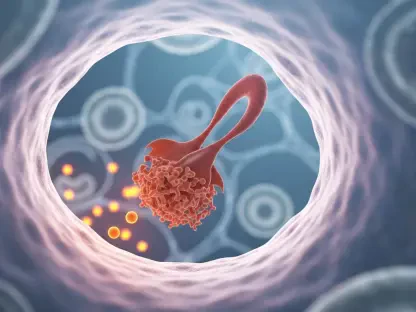In the rapidly evolving landscape of regenerative medicine, a groundbreaking biomaterial known as recombinant human type III collagen (rhCol III) is capturing the attention of scientists and medical professionals alike, marking a significant advancement. This innovative substance, crafted through sophisticated genetic engineering techniques, stands as a safer and more adaptable alternative to traditional animal-derived collagen, eliminating risks such as pathogens and inconsistent quality. Its emergence marks a pivotal moment in tissue engineering, a field dedicated to repairing and regenerating damaged human tissues. With the ability to closely mimic the natural structure of soft tissues like skin, blood vessels, and tendons, rhCol III is poised to redefine how medical treatments are approached. By providing a customizable and reliable platform for creating tissue scaffolds, it addresses longstanding challenges in healing and restoration, opening doors to solutions that were once thought impossible. This exploration delves into the unique attributes, diverse applications, and future potential of rhCol III in transforming patient care.
Unveiling the Distinctive Traits of rhCol III
The allure of rhCol III lies in its remarkable ability to replicate the extracellular matrix (ECM), the natural framework that supports cell growth and tissue repair within the human body. Unlike type I collagen, which offers rigidity suitable for bones, type III collagen brings a unique flexibility and elasticity critical for softer tissues such as skin and tendons. This characteristic enables rhCol III to serve as an ideal scaffold material, fostering seamless integration with surrounding biological structures. Its biocompatibility ensures that the body accepts these engineered tissues with minimal adverse reactions, a significant advantage over older materials that often triggered complications. Produced through microbial or mammalian expression systems, this biomaterial achieves a level of purity that sets a new standard in safety, making it a trusted option for a wide range of medical applications.
Beyond its structural mimicry, rhCol III offers a consistency that traditional collagen sources struggle to match. Animal-derived collagen frequently suffers from batch-to-batch variability and the risk of immune responses due to residual impurities. In contrast, the controlled production of rhCol III through genetic engineering minimizes these concerns, ensuring a uniform product free from pathogens. This reliability is crucial for clinical settings where predictable outcomes are paramount. Additionally, the ability to tailor its properties during production allows for customization to specific therapeutic needs, whether for delicate skin regeneration or more dynamic tissue support. As research continues to refine these processes, the potential for rhCol III to become a cornerstone of regenerative therapies grows, promising safer and more effective solutions for patients worldwide.
Broad Applications Across Medical Fields
One of the most compelling aspects of rhCol III is its versatility in addressing a spectrum of tissue engineering challenges, starting with bone repair. In cases of severe bone defects, often caused by trauma or disease, this biomaterial plays a vital role in accelerating recovery. By promoting vascularization—the formation of new blood vessels—rhCol III ensures that essential nutrients and oxygen reach the damaged site, supporting tissue regeneration. It also attracts osteoprogenitor cells, which are critical for forming new bone tissue, thus enhancing the healing process. When combined with growth factors, its regenerative effects are amplified, leading to not only structural restoration but also functional recovery. This makes rhCol III a powerful tool in orthopedic applications, offering hope to patients facing long and uncertain healing journeys.
Equally transformative is the impact of rhCol III in soft tissue engineering, particularly in the realm of chronic wound healing. Persistent wounds, often a complication of diabetes or surgical procedures, pose significant challenges due to slow recovery and high infection risks. Here, rhCol III scaffolds support the infiltration of fibroblasts and promote angiogenesis, facilitating the growth of new blood vessels to nourish the healing tissue. Its natural anti-inflammatory properties help reduce scarring, a common issue that can impair both function and appearance. Patients benefit from faster closure of wounds and a lower likelihood of complications, improving overall quality of life. This application underscores the material’s potential to address unmet needs in dermatology and post-surgical care, paving the way for more effective treatment protocols in clinical practice.
Harnessing Immune Modulation for Healing
A standout feature of rhCol III is its capacity to modulate immune responses, a critical factor in successful tissue regeneration. Unlike many synthetic or animal-derived materials that can exacerbate inflammation, this biomaterial actively shifts the inflammatory microenvironment toward a pro-regenerative state. By interacting with immune cells, it encourages resolution rather than chronic inflammation or fibrosis, which often leads to scarring. This property is particularly valuable in managing conditions where inflammation hinders healing, such as chronic wounds or autoimmune-related tissue damage. The ability to create a healing-friendly environment positions rhCol III as a game-changer in regenerative medicine, offering new strategies for tackling complex medical challenges.
This immunomodulatory effect also proves instrumental in enhancing outcomes for transplant surgeries and graft integration. When foreign tissues or materials are introduced into the body, the risk of rejection due to immune reactions is a significant concern. rhCol III helps mitigate this by fostering a more favorable immune response, reducing the likelihood of adverse outcomes. Its role in calming inflammatory pathways while supporting tissue integration can lead to better long-term success rates for patients undergoing such procedures. As studies continue to explore these mechanisms, the potential for rhCol III to improve compatibility and durability of transplanted tissues becomes increasingly evident, promising a future where surgical interventions carry fewer risks and greater reliability.
Navigating Obstacles in Clinical Adoption
Despite the immense promise of rhCol III, translating its benefits from laboratory research to widespread clinical use presents notable challenges. One primary limitation is its inherently softer and more compliant nature, which, while ideal for soft tissues, restricts its effectiveness in load-bearing applications like certain bone repairs. To overcome this, researchers are exploring techniques such as cross-linking or combining rhCol III with synthetic polymers to enhance mechanical strength without sacrificing biocompatibility. These innovations aim to broaden the scope of applications, ensuring that the material can support a wider range of structural demands. Addressing this balance between flexibility and durability remains a key focus for advancing its practical utility in diverse medical scenarios.
Another hurdle lies in scaling up production to meet the demands of clinical and commercial use while maintaining the high standards of purity and bioactivity that define rhCol III. The complexity of genetic engineering processes, coupled with the need for stringent quality control, drives up costs and poses logistical challenges. Innovations in bioreactor design and fermentation optimization are underway to streamline manufacturing, aiming to make this biomaterial more accessible and affordable. Regulatory compliance adds another layer of difficulty, requiring extensive long-term studies to confirm safety and efficacy across varied patient populations. Collaborative efforts between scientists, engineers, and regulatory bodies are essential to navigate these obstacles, ensuring that rhCol III can transition smoothly into mainstream medical practice.
Envisioning a Future with Cutting-Edge Integration
Looking ahead, the integration of rhCol III with emerging technologies like 3D bioprinting holds transformative potential for tissue engineering. This advanced technique allows for the precise fabrication of tissue constructs, layer by layer, using rhCol III as a bio-ink to create structures that mirror the complexity of native tissues. Such precision opens the door to patient-specific solutions, where scaffolds can be tailored to match individual anatomical and biomechanical needs. This approach could revolutionize treatments for conditions ranging from severe burns to organ damage, offering bespoke therapies that enhance recovery and reduce complications. The synergy between rhCol III and 3D bioprinting signifies a leap toward truly personalized medicine, redefining what is achievable in regenerative care.
Complementing this is the potential of gene editing technologies to further enhance the capabilities of rhCol III. By fine-tuning the genetic sequences used in its production, scientists can optimize properties like elasticity or immune modulation to suit specific therapeutic goals. This level of customization could address current limitations, such as mechanical strength, and expand applications into new frontiers of medical treatment. As these technologies mature, the vision of creating fully functional, engineered tissues that integrate seamlessly with the human body becomes increasingly tangible. Continued investment in research and interdisciplinary collaboration will be crucial to realizing these advancements, ensuring that rhCol III remains at the forefront of innovation in tissue engineering for years to come.
Pioneering Steps Toward Regenerative Breakthroughs
Reflecting on the journey of rhCol III, it is clear that this biomaterial has carved a significant path in regenerative medicine through its unparalleled safety and adaptability. Its applications in bone repair and soft tissue regeneration have demonstrated tangible improvements in healing speed and patient outcomes, while its ability to modulate immune responses has offered novel solutions for complex conditions. Challenges in mechanical performance and production scale have been met with determined efforts to innovate, from cross-linking techniques to optimized manufacturing processes. The past achievements of rhCol III underscore a collective resolve within the scientific community to push boundaries. Moving forward, the focus should center on accelerating clinical trials and fostering partnerships to integrate this material with technologies like 3D bioprinting. By prioritizing these steps, the full spectrum of rhCol III’s potential can be unlocked, ensuring that future generations benefit from advanced, life-changing therapies.









